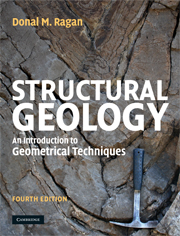Book contents
- Frontmatter
- Contents
- Preface
- Acknowledgements
- 1 Structural planes
- 2 Thickness and depth
- 3 Lines and intersecting planes
- 4 Planes and topography
- 5 Stereographic projection
- 6 Rotations
- 7 Vectors
- 8 Faults
- 9 Stress
- 10 Faulting
- 11 Deformation
- 12 Strain
- 13 Flow
- 14 Folds
- 15 Parallel folds
- 16 Similar folds
- 17 Folds and topography
- 18 Structural analysis
- 19 Tectonites
- 20 Drill hole data
- 21 Maps and cross sections
- 22 Block diagrams
- Appendices
- References
- Index
19 - Tectonites
Published online by Cambridge University Press: 05 June 2012
- Frontmatter
- Contents
- Preface
- Acknowledgements
- 1 Structural planes
- 2 Thickness and depth
- 3 Lines and intersecting planes
- 4 Planes and topography
- 5 Stereographic projection
- 6 Rotations
- 7 Vectors
- 8 Faults
- 9 Stress
- 10 Faulting
- 11 Deformation
- 12 Strain
- 13 Flow
- 14 Folds
- 15 Parallel folds
- 16 Similar folds
- 17 Folds and topography
- 18 Structural analysis
- 19 Tectonites
- 20 Drill hole data
- 21 Maps and cross sections
- 22 Block diagrams
- Appendices
- References
- Index
Summary
Introduction
The term fabric includes the complete spatial and geometrical configuration of all the components that make up a rock. It is an all-encompassing term that describes the shapes and characters of individual parts of a rock mass and the manner in which these parts are distributed and oriented in space (Hobbs, et al., 1976, p. 73). These components and their boundaries are elements of the fabric. A description of the manner in which these elements and the boundaries between them are arranged in space constitutes a statement of the fabric of the body.
Isotropy and homogeneity
A rock with randomly oriented fabric elements will have the same physical and geometrical properties in all directions, and is therefore isotropic. Such rocks are rare in nature. Usually the best that can be said is that a rock mass is approximately isotropic on some specified scale.
If any two identically oriented, equal-volume samples taken from a rock mass are identical in every respect, the mass from which they came is said to be homogeneous. At best, some rock masses are only quasi-homogeneous, that is, the proportions of the various mineral components and their distribution are only approximately uniform. Samples from such a mass that are large compared with the grain size will then be statistically indistinguishable, and the mass is said to be statistically homogeneous.
- Type
- Chapter
- Information
- Structural GeologyAn Introduction to Geometrical Techniques, pp. 493 - 503Publisher: Cambridge University PressPrint publication year: 2009



